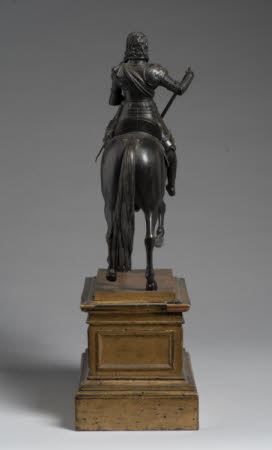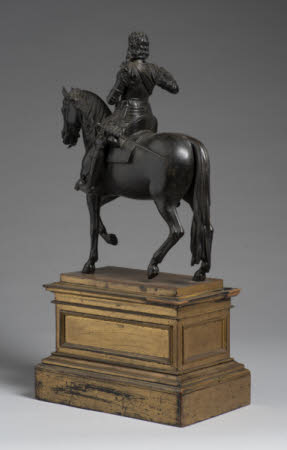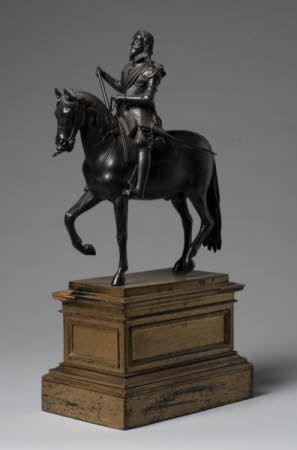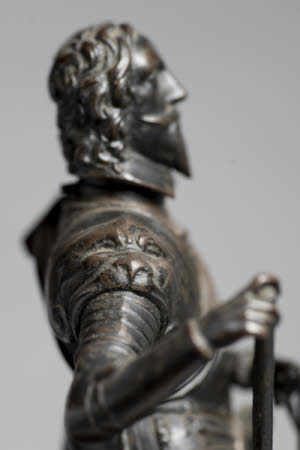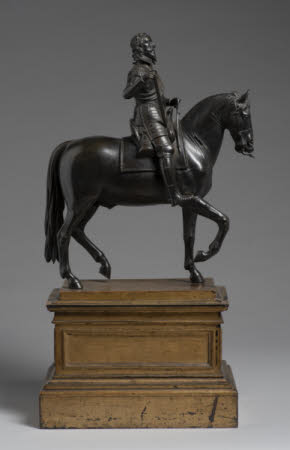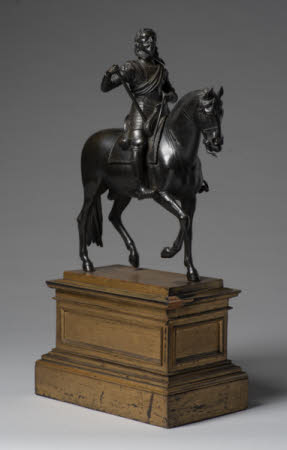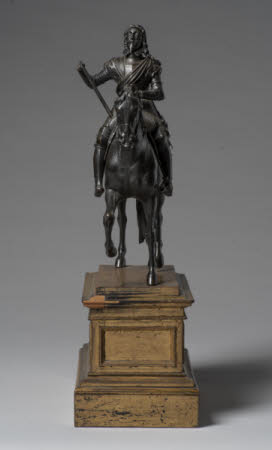King Charles I (1600-1649) on horseback
attributed to Hubert Le Sueur (c.1580 - Paris 1658)
Category
Art / Sculpture
Date
c. 1633
Materials
Bronze on wood
Measurements
330 x 280 mm;175 mm (Height)
Place of origin
England
Order this imageCollection
Ickworth, Suffolk
NT 850841
Caption
The monumental equestrian statue, called ‘Carolus Magnus’ (with flattering reference to the emperor Charlemagne), for which this is the statuette once owned by Charles I himself, was commissioned in 1630 by Sir Richard Weston (1577 - 1634/35), Lord Treasurer, and later Earl of Portland. Le Sueur was encouraged to ‘take the advice of the King's riders of great horses for the shape and action both of the horse and his Majesty's figure on the same’. Presumably this small reduced piece embodies the results of Le Sueur's studies in the royal stables. The larger work is signed and dated 1633. It disappeared and was hidden during the time of the Commonwealth and was not finally erected on a high pedestal at Charing Cross until sometime between 1675 and 1677 where it still stands today.
Summary
Sculpture, bronze; Equestrian statuette of King Charles I (1600-1649); attributed to Hubert le Sueur (c. 1580-1658); London, c. 1633. A small bronze reduction of the French sculptor Hubert le Sueur’s monumental bronze equestrian statue of King Charles I, in Trafalgar Square London. The Trafalgar Square sculpture was commissioned by the king’s Chancellor in 1630, in emulation of other large equestrian monuments in bronze that had in recent decades been erected in Florence, Madrid and Paris. Le Sueur, who came from Paris in the 1620s to work for Charles I, made many portraits of the monarch in the 1630s. The Ickworth statuette, which shows the king in full armour, may be identifiable with a bronze recorded in Charles I’s collection at Whitehall Palace, London, in 1638/39, which was then sold in 1651 in the Commonwealth sales.
Full description
Equestrian statuette depicting King Charles I on horseback, a reduction of the full-size bronze sculpture in Trafalgar Square. The King is dressed in full armour, with a commander’s sash over his left shoulder and a sword at his left side, but wears no order around his neck. In his right hand is a commander’s baton. He rides upon an alert horse, its ears pricked forward, its nostrils curled upwards; mane is combed onto left side of horse’s neck, the tail falls straight. Bridle separately cast, mostly now broken off. The sculpture is made in four main parts: the horse; the horse’s tail, fixed to the horse’s body by two screws; the body of the king and the saddle, fixed to the body of the horses with screws; the head of the king, now fixed in to the body. Mounted on a rectangular wooden base, with later painting to simulate gold. An unidentified, possibly Scottish, crest on one side of the base, just visible beneath the later overpaint. The son of a Parisian master-armourer, Hubert le Sueur was first recorded as working in Paris as a sculptor in 1604; by 1612 he was working for the French royal family. After the marriage in May 1625 of Henrietta Maria, sister of the French king Louis XIII, to Charles I, king of England, Scotland and Ireland, Hubert le Sueur was summoned to London to work for the new monarch, whom he served as court sculptor until the outbreak of the Civil War. After hostilities had begun, Le Sueur quickly returned to France to resume his career across the Channel. Throughout his career in both France and England, Hubert le Sueur was more highly regarded for his proficiency as a bronze founder than for his imaginative powers. Whilst working for Charles I, he made a number of portraits of the monarch, as well as some of his queen. His busts of King Charles I, which invariably show the king wearing armour, are in the well-established tradition of European royal portrait sculpture. The best are competent efforts, although they hardly begin to approach the brilliance of contemporary Roman Baroque sculptors such as Gian Lorenzo Bernini or Alessandro Algardi. The finest of Le Sueur’s portraits of King Charles I is at Stourhead (NT 731855) whilst other portrait busts of the king after models by the sculptor in National Trust collections, some of them nineteenth-century bronze casts, are at Kingston Lacy (NT 1255241), Petworth (NT 485247) and The Vyne (NT 719099). A fine bronze portrait bust by Le Sueur of Edward Herbert, 1st Baron Herbert of Cherbury (1581/2-1648), dated 1631, is at Powis Castle (NT 1181001). The small equestrian statuette follows closely if not precisely Hubert le Sueur’s best-known sculpture, the monumental bronze equestrian statue of King Charles I, in Trafalgar Square, London. This sculpture was commissioned in 1630, not by the monarch, but by the Lord Treasurer, Sir Richard Weston (1577-1634/35; created Earl of Portland in 1633) for the garden of his house in Mortlake (Avery 1982, pp. 176-77, no. 14; Ward-Jackson 2012, pp. 288–91). In commissioning the work, Sir Richard Weston was following in particular the example of Giambologna (1529-1608), in whose Florentine workshops several equestrian statues of European rulers had recently been produced, beginning with the triumphal equestrian statue of Grand Duke Cosimo I de’Medici of Tuscany for the Piazza della Signoria in Florence, completed in 1594. This was followed by other equestrian statues made under the supervision of Giambologna’s principal assistant Pietro Tacca, depicting Cosimo’s son Grand Duke Ferdinando I (Florence, Piazza Santissima Annunziata) completed in 1608, King Henri IV of France, completed in 1612 but only installed on the Pont Neuf in Paris in 1614 (destroyed in 1792 during the French Revolution) and King Phillip III of Spain (Plaza Mayor, Madrid), completed in 1614. Contemporaries were well aware of these European precedents. Henry Peacham wrote in the 1634 edition of his 'The Compleat Gentleman' that ‘the great Horse with his Majestie upon it, twice as great as the life, and now well-nigh finished, will compare with that of the New-bridge at Paris, or those others at Florence and Madrid’ (Peacham 1634, p. 108). In reality, Hubert le Sueur’s equestrian Charles I does not approach the sophistication and elegance of Giambologna’s creations, although it has an impressive monumentality and bold treatment of form. It ought not to have survived the turmoil of the Civil War years, since in 1644 Parliament ordered the sculpture, then in Roehampton, to be seized and melted down. It was not until after the Restoration that it came to light again, a brazier John Rivett having bought it during the Commonwealth years and pretended that he had followed instructions to break it up. The monument was reclaimed by the 2nd Earl of Portland and bought from his widow in 1675 by King Charles II, who had it erected in Trafalgar Square, on a pedestal designed by Sir Christopher Wren. The statuette at Ickworth is easily recognizable as a reduction from the Trafalgar Square sculpture, although it varies in some small details, for example the turn of the horse’s head. It shares with the larger statue the bizarre wrinkling of the horse’s nostrils, suggesting the snorting of a war horse. The figure of the king differs in the armour that he wears. In the Ickworth statuette the shoulder pieces (pauldrons) are in the form of lion heads and the figure wears armoured lower leg protection (greaves), rather than the leather riding boots in the larger monument. In making a small reduction derived from the larger monument, Hubert le Sueur was again following a precedent set by Giambologna, in whose workshop a number of smaller equestrian statuettes of rulers were produced, among them the statuette of King Henri IV of France in the Wallace Collection (Warren 2016, no. 114). In the Wallace Collection Henri IV, the head was separately made and inserted into an armoured torso, as is the case with the Ickworth statuette. This was the practice of other sculptors of smaller-scale equestrian statues, such as the German-born Caspar Gras (1585-1674), who worked for the Habsburg Archdukes of Tirol in Innsbruck. It allowed the same model of the torso to be used multiple times for different portraits, but helps to explain why, just as King Henri IV in the Wallace Collection statuette is not shown wearing the royal order of the Saint-Esprit, in the Ickworth figure Charles I does not wear the Order of the Garter, present in the monumental sculpture in Trafalgar Square. Hubert le Sueur made other similar small equestrian statuettes of monarchs, depicting King Louis XIII of France and King Philip III of Spain (both Victoria & Albert Museum, London; Avery 1982, nos. 7 & 8), with identical bodies and horses but different and separately-modelled heads. The horse in the Ickworth statuette is the closest to Giambologna’s horse models, and even more so to a horse designed and made by Giambologna’s assistant Antonio Susini (1558-1624), a signed version of which is in the V&A. All the same, this horse lacks the taut elegance of the Italian models. On the other hand Hubert le Sueur, whose father was an armourer and so grew up in the world of arms and armour, always paid great attention to the details of the armour and associated weapons worn by his figures. The Ickworth statuette is generally accepted as being identifiable with a bronze recorded in the inventory of King Charles I’s collections in the palace at Whitehall, drawn up in 1638-39, in which the sculpture was recorded as ‘Item yor Mats owne Picture on horsback upon a black wooden Peddistall’ and as ‘Done by the ffrench man’ (Millar 1960, p. 95). It was sold in the Commonwealth sales, listed as ‘The King on horseback at … £10.’ (Miller 1972, p. 273, no. 272). It is not known how the figure eventually found its way into the Hervey collections. There is another small bronze equestrian statuette of King Charles I in the Royal Collection, this time gilded (RCIN 29930). Like the Ickworth figure, Charles is not wearing the Order of the Garter. Although it too has occasionally been identified with the figure recorded in the 1638-39 inventory, it is much inferior to the Ickworth bronze, whilst the figure once at Whitehall Palace does not seem from the description to have been gilded. Although it seems more probable that the Ickworth statuette of King Charles I is indeed to be identified with the one recorded at Whitehall, it remains a puzzling sculpture. Although it is considerably better in quality than the version in the Royal Collection, both figure and horse are nevertheless inferior to the small signed bronze statuettes of Louis XIII and Philip III in the V&A, which were both probably made in the early 1620s, before Le Sueur was brought to Britain. It is also curious that the Ickworth and Royal Collection statuettes, with their detachable heads and lack of identifying chivalric orders, are made in such a way as to imply they were conceived for serial production, but that no other related statuettes are known. Perhaps some sort of series was planned, but it was then decided not to take it further. Another small equestrian bronze statuette of King Charles I has recently emerged on the art market, from the collections of the Earls of Leitrim (Avery 2011). It is attributed to Francesco Fanelli (1577- before 1652), who also came to London to work for the king, but was a more inventive and imaginative artist than Hubert le Sueur. In this figure, the king is shown wearing an indeterminate order on a ribbon around his neck. Jeremy Warren June 2025
Provenance
King Charles I (1600-49); probably the bronze recorded at Whitehall in 1638-39; sold in the Commonwealth sales, 23 October 1651, for £10, to Jackson. Probably Frederick Augustus Hervey, 4th Earl of Bristol (1730-1803); acquired by the National Trust in 1956 under the auspices of the National Land Fund, later the National Heritage Memorial Fund.
Makers and roles
attributed to Hubert Le Sueur (c.1580 - Paris 1658), sculptor
References
Peacham, Henry, 1576?-1643? compleat gentleman. 1634. Vertue 1862 G. Vertue, Anecdotes of Painting in England, 3 vols., 1862, II, p. 394 Denoon 1933 D. G. Denoon, ‘The statue of King Charles I at Charing Cross’,Transactions of the London and Middlesex Archaeological Society, new ser., 6 (1933), pp. 460–85 Avery 1979 Charles Avery, 'Hubert le Sueur’s portraits of King Charles I in bronze, at Stourhead, Ickworth and elsewhere' National Trust Studies 147 (1979), pp.128-47 Avery 1981 Charles Avery, 'Hubert le Sueur’s portraits of King Charles I in bronze, at Stourhead, Ickworth and elsewhere' Studies in European Sculpture 1 (1981), pp.189-204 Avery 1982: Charles Avery, 'Hubert Le Sueur, the 'unworthy Praxiteles' of King Charles I', The Walpole Society, Vol. 48 (1980-82), pp. 135-209, pp. 177-78, Pl. 49. Evelyn 2000: Peta Evelyn, ‘The Equestrian Bronzes of Hubert Le Sueur’ in Sabine Eiche (ed.), Giambologna tra Firenze e l’Europa, Florence 2000, pp. 141-56, p. 152. Ward-Jackson 2011: Philip Ward-Jackson, Public Sculpture of Historic Westminster. Volume I, Liverpool 2011, p. 290. Warren 2016: Jeremy Warren, The Wallace Collection. Catalogue of Italian Sculpture, 2 vols., London 2016 Shawe-Taylor 2018: Desmond Shawe-Taylor and Per Rumberg (eds.), Charles I: King and Collector, (exh. cat.), Royal Academy of Arts, London: 2018, no. 137.
